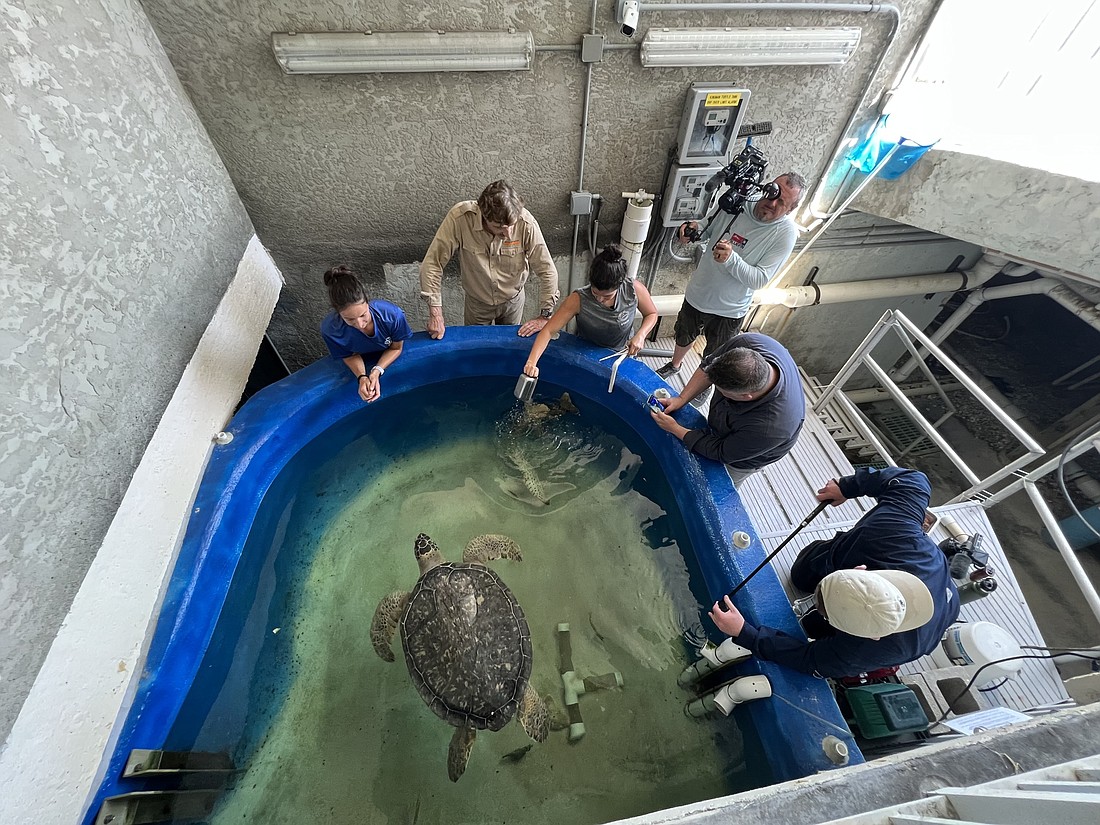- April 18, 2024
-
-
Loading

Loading

Nesting turtles and mating manatees are the summer stars of Longboat Key, but they’re about to get national attention thanks to a reboot of "Mutual of Omaha’s Wild Kingdom," which concluded its original 25-year run in 1988.
The latest episode, "Protecting the Wild," was filmed in the rehabilitation center at Mote Marine Laboratory & Aquarium on July 13. Mote was the perfect subject and setting because of its research and conservation efforts.
“It’s unique in that this is a research laboratory,” said host Peter Gros, now in the role made famous by Marlin Perkins from 1963 to 1985. “They’re doing a lot of scientific work, and now they’re sharing that knowledge with the public that comes through.”
Mote’s acoustic research will be featured in the episode. Researchers are studying manatee reactions on site and in the wild. They want to know how stressed they become in proximity to the sounds created by boats and people. Similar data exists on dolphins and sea otters, but not on manatees yet.
“The science that’s happening here is going to help us as conservationists, beyond Mote, to be able to say, ‘Hey folks, you need to keep 50 yards' distance or whatever that number is,’” National Wildlife Federation Naturalist David Mizejewski said. “Then we can take it the next step further and advocacy groups can start saying we need to pass this regulation, and that’s how it all feeds together.”
In the social media age, this kind of data is more important than ever. Gros recommends putting your cell phone away and grabbing a pair of binoculars instead when out in the wild.
“Selfies, in a sense, have become a threat to our endangered species,” he said. “Appreciate the animals, giving them distance and eliminating the stress.”
Production has followed suit. "Protecting the Wild" makes its debut in January to coincide with the 60th anniversary of the first episode. Thanks to technology including drones and motion cameras, filming is far less invasive now.
Both Gros and Mizejewski applauded the local community for the awareness and concern they show the area’s wildlife and say community involvement is at the crux of conservation. Whether it be through a donation to an advocacy group or turning lights off so baby sea turtles don’t crawl in the wrong direction, it makes a difference.
“We all have these opportunities, and that’s a big message that we give at the National Wildlife Federation,” Mizejewski said. "That’s why we’ve teamed up. Because together, we hopefully can reach millions of people with the show and these messages.”
The show’s theme is conservation success, and Longboat Key has set a stellar example. Longboat Key Turtle Watch operates under Mote's tutelage, but it's a volunteer group. Nesting numbers are the seventh highest on record this year; and a critically endangered Kemp’s Ridley sea turtle nest hatched this month.
“The fact that you’re starting to see a nest and they’re returning is such a good indicator that they may start returning more and more,” Gros said. "The people of Longboat Key seem to be so personally involved with protecting that species, I think they have a really good chance.”
Long before Gros knew he’d build a television career out of his love for animals, he took a family vacation to Siesta Key. His twin sons were about 8 at the time, and he pointed out a sea turtle nest surrounded by yellow flags.
“I remember explaining what was going to happen and how far these turtles had swum to do this,” he said.
Years later, he was filming on the Great Barrier Reef where loggerheads leave their nests for 30 years and retrace their steps over 3,000 miles back to the same location to lay their eggs. He calls it “one of the miracles of nature that we don’t completely understand yet,” and said he’ll never forget the experience.
Since walking Siesta Key's beach with his sons, Gros has taught countless other children and adults the importance of conservation, and his passion hasn’t waned.
“This is a lifetime dream and opportunity for me to continue Mutual’s goal of educating people about conservation,” he said.
Ten episodes of "Wild Kingdom: Protecting the Wild" are set to air on RFD-TV and digital channels starting Jan. 23.
This article has been updated.